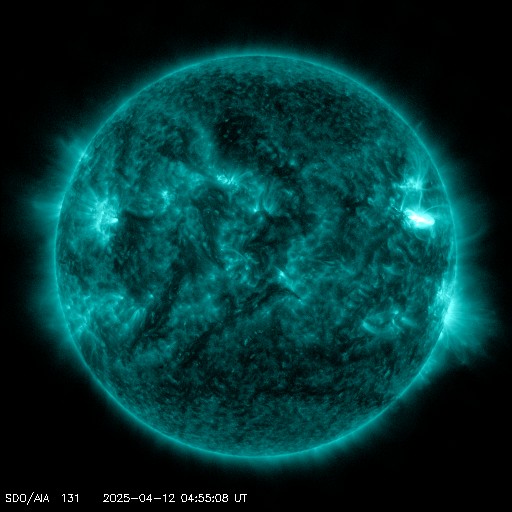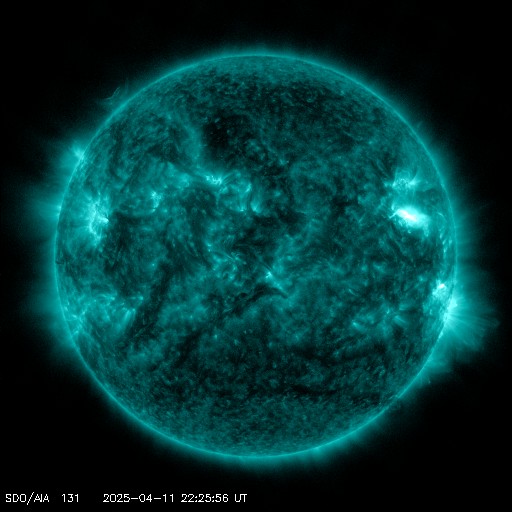Viewing archive of Tuesday, 6 November 2001
Solar activity report
Any mentioned solar flare in this report has a scaling factor applied by the Space Weather Prediction Center (SWPC). Because of the SWPC scaling factor, solar flares are reported as 42% smaller than for the science quality data. The scaling factor has been removed from our archived solar flare data to reflect the true physical units.
Report of Solar-Geophysical Activity 2001 Nov 06 2200 UTCPrepared by the NOAA © SWPC and processed by SpaceWeatherLive.com
Joint USAF/NOAA Report of Solar and Geophysical Activity
SDF Number 310 Issued at 2200Z on 06 Nov 2001IA. Analysis of Solar Active Regions and Activity from 05-2100Z to 06-2100Z
Solar activity was at moderate levels. Four M-class
events were reported during the period. Region 9687 (S20E08)
produced the largest event, an M2/1b flare at 06/0300 UTC. This
event also had an accompanying Type II radio sweep (velocity
estimated at 600 km/s). Region 9687 developed into a complex
beta-gamma-delta magnetic classification during the period. Region
9690 was by far, the most active region on the disk today. It
produced several C-class events and two minor M-class events. Region
9690 has fully rotated onto the disk and appears to be a moderately
large region (750 millionths) with a beta-gamma magnetic
classification. Region 9684 (N06W55), which produced the X1/3b
proton flare on 04 November, retains a beta-gamma-delta magnetic
classification, but did not produce any significant activity during
the period.
IB. Solar Activity Forecast
Solar activity is expected to continue
to be moderate to high. Regions 9684, 9687, and 9690 all possess
major flare potential.
IIA. Geophysical Activity Summary 05-2100Z to 06-2100Z
The geomagnetic field was at unsettled to severe storm conditions.
The full-halo coronal mass ejection (CME) from the 04 November event
impacted the geomagnetic field at 06/0150 UTC. This was indicated by
a 90 nT sudden impulse as measured by the USGS Boulder magnetometer.
Severe geomagnetic storming occurred between 06/0000 and 06/0600 UTC
and 15-1800 UTC. The greater than 10 MeV proton event peaked at
31,700 pfu at 06/0215 UTC. The greater than 100 MeV proton event
peaked at 253 pfu at 06/0220 UTC. Both proton events levels declined
sharply during the period but continued through the end of the day.
A polar cap absorption event remained in effect.
IIB. Geophysical Activity Forecast
The geomagnetic field is
expected to be unsettled to minor storm conditions on the first day
of the period and then declining to mostly quiet to unsettled, with
isolated active conditions possible, on days two and three. However,
there have been several long and near long duration flares in the
last two days that could have produced earth-directed coronal mass
ejections. Since the onset of the proton storm at approximately 1700
UTC on 04 November, the LASCO instrument has been saturated by the
particles and it is nearly impossible to determine if any CME's have
been produced or if they are earth-directed. Impacts from any
earth-directed CME's would obviously cause an increase in
geomagnetic activity. The greater than 100 MeV proton event is
expected to continue until approximately 07/1200 UTC. The greater
than 10 MeV proton event ended the day at 567 pfu and is expected to
continue for at least another 24 hours. The Polar cap absorption
event is expected to last until 09/0000 UTC.
III. Event Probabilities 07 Nov to 09 Nov
| Class M | 80% | 80% | 80% |
| Class X | 25% | 25% | 25% |
| Proton | 99% | 99% | 80% |
| PCAF | in progress | ||
IV. Penticton 10.7 cm Flux
Observed 06 Nov 237 Predicted 07 Nov-09 Nov 235/235/230 90 Day Mean 06 Nov 208
V. Geomagnetic A Indices
Observed Afr/Ap 05 Nov 012/013 Estimated Afr/Ap 06 Nov 075/100 Predicted Afr/Ap 07 Nov-09 Nov 030/030-012/015-010/012
VI. Geomagnetic Activity Probabilities 07 Nov to 09 Nov
| A. Middle Latitudes | |||
|---|---|---|---|
| Active | 50% | 35% | 35% |
| Minor storm | 25% | 15% | 15% |
| Major-severe storm | 04% | 04% | 04% |
| B. High Latitudes | |||
|---|---|---|---|
| Active | 40% | 30% | 25% |
| Minor storm | 35% | 15% | 15% |
| Major-severe storm | 20% | 10% | 05% |
All times in UTC
Current data suggests there is a slight possibility for aurora to appear at the following high latitude regions in the near future
Gillam, MB, Yellowknife, NTLatest news
Latest forum messages
More topicsSupport SpaceWeatherLive.com!
A lot of people come to SpaceWeatherLive to follow the Sun's activity or if there is aurora to be seen, but with more traffic comes higher server costs. Consider a donation if you enjoy SpaceWeatherLive so we can keep the website online!

Latest alerts
05:03 UTC - Solar flare
Moderate M1.19 flare
04:48 UTC - Radio Blackout
Minor R1 radio blackout in progress (≥M1 - current: M1.17)
Friday, 11 April 2025
22:39 UTC - Solar flare
Moderate M1.05 flare
22:24 UTC - Hemispheric Power Index
The OVATION model predicts the Hemispheric Power Index to reach 50GW at 23:16 UTC
22:24 UTC - Radio Blackout
Minor R1 radio blackout in progress (≥M1 - current: M1.05)
Space weather facts
| Last X-flare | 2025/03/28 | X1.1 |
| Last M-flare | 2025/04/11 | M1.0 |
| Last geomagnetic storm | 2025/04/06 | Kp5 (G1) |
| Spotless days | |
|---|---|
| Last spotless day | 2022/06/08 |
| Monthly mean Sunspot Number | |
|---|---|
| March 2025 | 134.2 -20.4 |
| April 2025 | 139.5 +5.3 |
| Last 30 days | 136.6 -3.5 |




